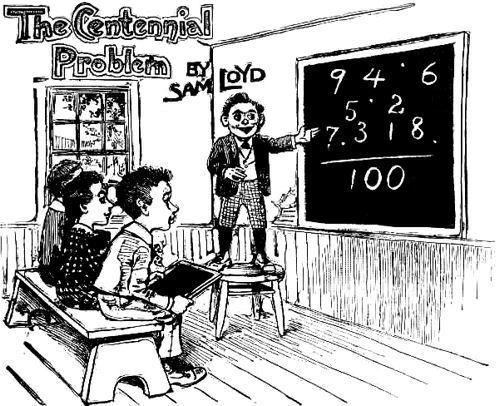



OVER A QUARTER OF a century ago, when the centennial of 1776 was duly celebrated in Philadelphia by a grand exposition. I designed a little arithmetical puzzle, which gave rise to considerable discussion. The conditions of the problem, correctly stated, were to arrange the figures 1 2 3 4 5 6 7 8 9 and the four dots [In Loyd's day a dot (·) or dash was used to express a fraction. E.g 1-2 is equivalent to 1/2. ‚Ä” jws] in such a way that they would add up so as to make exactly 100. The puzzle was quoted and republished all over the world, accompanied by explanations or criticisms so different from those actually expressed and intended that the real answer was never published. Owing to the fact, therefore, that scores of solutions which were supposed to fill the bill, would not fairly satisfy the conditions, I am sure that it will interest such readers to discover wherein they were mistaken, for which reason the terms are again stated: Simply arrange the figures and dots so that by one addition, without the use of signs or numbers other than those shown on the black board, they will make the given answer of 100 correct.
Despite its apparent simplicity, this little puzzle embodies a most scientific mathematical principle which every one should know, and it is now given to introduce or pave the way for a new and interesting class of puzzles, which explains an important and interesting feature, which every teacher and lover of mathematics or even elementary arithmetic should understand.
24 3/6 95 3/7
75 9/18 4 16/28
-------- ---------
100 100
98 3/6 94 1/2
1 27/54 5 38/76
--------- ---------
100 100
1 6/7
3 57 3/6
95 4/28 42 9/18
-------- --------
100 100
2. A Poetical Perplexity.
Here is a clever potpourri of well- known lines to test a person's acquaintance with famous authors:
The curfew tolls the knell of parting day
In every clime, from Lapland to Japan;
To fix one spark of beauty's heavenly ray
The proper study of mankind is man.
Tell, for you can, what is it to be wise,
Sweet Auburn, loveliest village of the plain.
‚ÄúThe Man of Ross,‚ÄĚ each lisping babe replies,
And drags, at each remove, a lengthening chain.
Ah, who can tell how hard it is to climb
Far as the solar walk or milky way?
Procrastination is the thief of time,
Let Hercules himself do what he may.
'Tis education forms the common mind,
The feast of reason and the flow of soul;
I must be cruel only to be kind,
And waft a sigh from India to the pole.
Sphax! I joy to meet thee thus alone,
Where'er I roam, whatever lands I see;
A youth to fortune and to fame unknown,
In maiden meditation, fancy free.
In that Poetical Perplexity, the lines were written in the following order: Gray, Shakespeare, Byron, Pope, Pope, Goldsmith, Pope, Goldsmith, Beattie, Milton, Young, Shakespeare, Pope, Shakespeare, Shakespeare, Milton, Pope, Goldsmith, Gray, Shakespeare.
[Page 77]